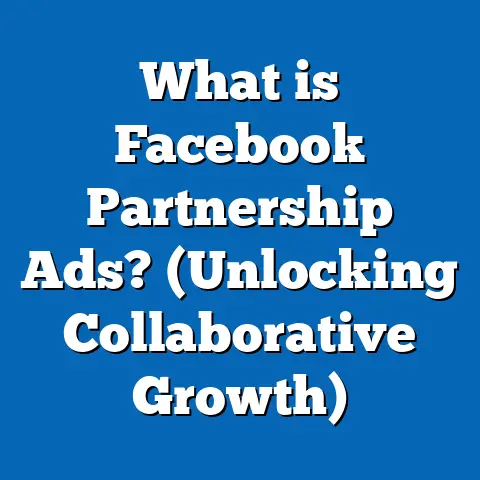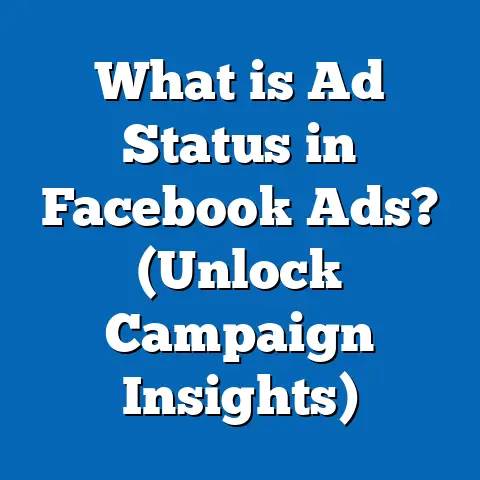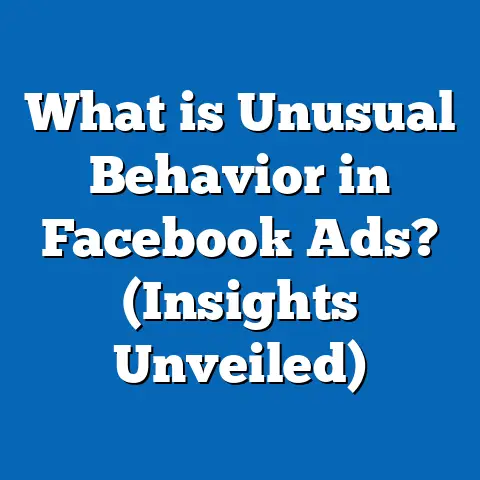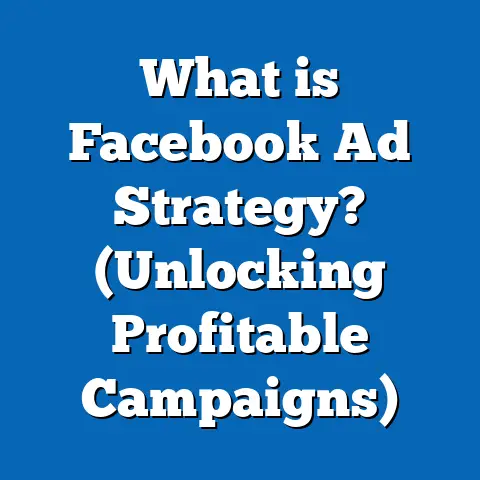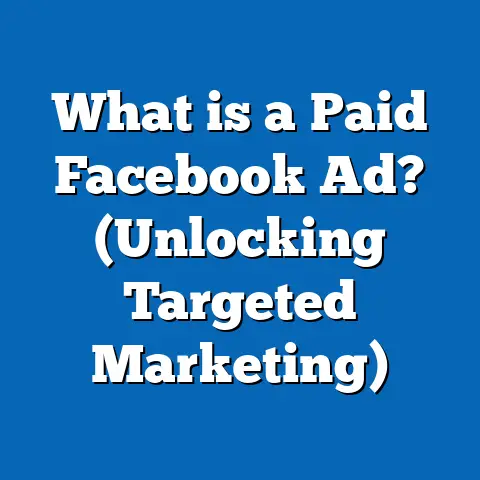What is the Ideal Potential Reach for Facebook Ads? (Unlock Your Target Audience)
What is the Ideal Potential Reach for Facebook Ads? (Unlock Your Target Audience)
Imagine waking up on a bright morning. You’re relaxing with your coffee, scrolling through your Facebook feed to catch up on friends’ updates and news. Suddenly, an ad pops up—it’s exactly what you need right now: a local gym offering a limited-time membership discount or a shoe brand launching a new collection that matches your style perfectly. It feels personal, timely, and almost as if it was made just for you.
For marketers and business owners, that precise moment of connection doesn’t happen by chance. Behind it lies a deep understanding of who their target audience is and how large or small their potential reach should be for their Facebook ads. The size of this potential reach is critical—it determines not only how many people see your ad but also how effectively your budget is used and how well your message resonates.
In the ever-evolving world of digital marketing, Facebook remains a top platform for advertisers worldwide. But success on Facebook Ads isn’t just about having a great creative or bidding high; it’s about precisely defining your potential reach—the number of people you can realistically target with your ad campaigns.
Understanding Potential Reach in Facebook Ads
What is Potential Reach?
Potential reach represents the estimated number of people who fit within the parameters you set when creating your Facebook ad targeting. This includes demographics such as age and gender, geographic location, interests, behaviors, language, device usage, and more.
Think of potential reach as the audience pool from which Facebook can draw to show your ads. For example, if you target women aged 25-34 living in New York City interested in fitness, Facebook calculates how many users fit that description and shows it as your potential reach.
Why Is Potential Reach Crucial?
Potential reach establishes the foundation for your campaign’s targeting strategy. It influences:
- Budget Allocation: A very large audience means your budget may be spread thinly; a very small audience may exhaust quickly or limit data collection.
- Ad Relevance: Facebook’s delivery system rewards ads that are relevant to their audience with better placement and lower costs.
- Optimization Efficiency: The algorithm needs sufficient scale to learn who responds best to your ads.
How is Potential Reach Calculated?
Facebook doesn’t reveal the exact algorithm behind potential reach estimation. However, it uses data from over 2.9 billion monthly users worldwide and factors such as:
- User profiles (age, gender)
- Interests (pages liked, activities)
- Behaviors (purchase habits)
- Location data
- Device types
- Language spoken
The potential reach adjusts dynamically as you add or remove targeting options.
Why Potential Reach Size Matters
The Balance Between Too Broad and Too Narrow
An ideal potential reach balances scale with precision. If your audience is too broad:
- Your ad spend may be wasted on uninterested users.
- Ad relevance scores may drop.
- CPM (cost per 1,000 impressions) may increase due to poor engagement.
If your audience is too narrow:
- You risk ad fatigue (same people seeing your ad repeatedly).
- Limited data reduces Facebook’s ability to optimize delivery.
- Campaign scalability becomes difficult.
Research Insights: Audience Size Impact on Performance
A comprehensive study by AdEspresso analyzed over 1,000 Facebook campaigns across industries in 2023:
| Audience Size Range | Average CTR | Conversion Rate | Notes |
|---|---|---|---|
| < 50,000 | 3.2% | 1.8% | High CTR but limited scale |
| 50,000 – 500,000 | 2.4% | 2.1% | Balanced engagement and conversions |
| 500,000 – 2 million | 2.1% | 2.5% | Good scale and optimization potential |
| > 5 million | 1.3% | 1.0% | Lower engagement, diluted messaging |
This reveals that mid-sized audiences tend to deliver the best balance of engagement and conversions.
How to Determine Your Ideal Potential Reach
Step 1: Define Your Campaign Goals
Are you aiming for brand awareness, lead generation, sales conversion, or app installs? Different goals require different audience sizes.
- Brand awareness: Larger audiences (millions) to maximize reach.
- Lead generation: Mid-sized audiences (hundreds of thousands) with precise targeting.
- Conversions: Smaller, highly targeted audiences for better ROI.
Step 2: Understand Your Customer Profile
Use existing data such as customer demographics, purchase behavior, website analytics, and CRM information to build detailed buyer personas.
Example Persona:
| Attribute | Description |
|---|---|
| Age | 30-45 years |
| Gender | Male |
| Location | Urban areas of California |
| Interests | Tech gadgets, fitness |
| Behavior | Online shopper |
Step 3: Use Facebook Audience Insights Tool
Facebook’s Audience Insights tool helps estimate the size of an audience based on your selected criteria.
- Enter demographics.
- Add interests and behaviors.
- Check estimated audience size.
Step 4: Calculate Potential Reach
Combine all targeting dimensions and review the resulting potential reach. Adjust parameters if it’s too large or too small.
Detailed Breakdown: Targeting Dimensions Affecting Potential Reach
Demographics
Basic demographic filters include:
- Age groups (e.g., 18-24, 25-34)
- Gender
- Relationship status
- Education level
- Job titles
Narrowing demographics can drastically reduce potential reach but increases ad relevance.
Location Targeting
Location targeting can be set at multiple levels:
- Country
- State/Province
- City
- Postal code
- Radius around a point
Example:
- Targeting the entire USA: ~200 million users.
- Targeting New York City: ~7.5 million users.
- Targeting a 10-mile radius around NYC: ~1 million users.
Interests & Behaviors
Facebook categorizes interests with over 1,500 options such as sports, hobbies, technology.
Behavioral targeting includes purchase behavior like “Frequent online shoppers,” device usage (iOS vs Android), and travel habits.
Language & Device Types
Language filters are critical for international campaigns.
Device type targeting helps optimize campaigns for mobile or desktop users specifically.
Advanced Audience Segmentation Techniques
Lookalike Audiences
Lookalike audiences allow advertisers to reach new people similar to their current customers based on data such as website visitors or customer lists.
Key Points:
- Can select from 1% (closest match) to 10% (broader match) of the population.
- Typically used for scaling campaigns after initial success.
Research shows:
- 1%-2% lookalikes give better conversion rates.
- Larger lookalikes increase scale but reduce precision.
Custom Audiences
Custom audiences are built from existing customer data such as email lists or website visitors via Facebook Pixel.
Advantages:
- Highly targeted.
- Lower CPM due to higher relevance.
Limitation:
- Usually smaller in size; ideal for retargeting or upselling campaigns.
Layering Targeting Options
You can layer demographics with interests and behaviors to create highly specific audiences.
Example: Women aged 25-34 interested in yoga + online shopping + fitness trackers.
Caution: Overlayering can shrink potential reach excessively and limit data for optimization.
Case Studies: Real World Examples and Data
Case Study 1: Local Organic Juice Bar
Objective: Increase foot traffic through Facebook ads targeting local health-conscious consumers.
Targeting: Women aged 25-45 within 5 miles radius interested in organic food and wellness.
Potential Reach: ~40,000 users.
Outcome:
- CTR of 3.5%
- Conversion rate (store visits) increased by 15%
- Budget optimized efficiently due to narrow but relevant audience size.
Case Study 2: National E-commerce Apparel Brand
Objective: Drive online sales during holiday season.
Targeting: Men and women aged 18-45 across the USA interested in fashion and online shopping.
Potential Reach: ~12 million users.
Strategy: Used multiple ad sets with lookalike audiences at 1%, 3%, and broad interest-based targeting.
Outcome:
- CTR averaged 1.8%
- ROAS (Return on Ad Spend) improved by 25% compared to previous year.
Campaign Setup: How to Find Your Ideal Potential Reach Step-by-Step
Step 1: Start Broad then Narrow Down
Begin with broader categories to gather data on performance before refining your audience based on insights.
Step 2: Use Split Testing (A/B Tests)
Test different audience sizes and compositions:
- Test broad vs narrow targeting.
- Test different interest combinations.
Monitor which performs better for CTR and conversions.
Step 3: Monitor Frequency Metrics
Frequency shows how many times the average person sees your ad. High frequency (>3) with low engagement indicates audience fatigue; consider expanding reach.
Step 4: Adjust Based on Metrics
If CPM increases or CTR drops:
- Expand target audience.
- Refresh creatives.
If frequency is low but conversions are good:
- Consider narrowing reach for more focused messaging.
Comparing Facebook Potential Reach with Other Platforms
| Platform | User Base Size | Targeting Precision | Ideal Audience Size Range |
|---|---|---|---|
| 2.9+ billion monthly users | Detailed demographics & interests | 50K – several million | |
| Over 2 billion monthly users | Similar to Facebook but younger skew | Similar to Facebook | |
| ~900 million users | Professional targeting (jobs) | Smaller niche audiences | |
| Google Ads | Billions via Search & Display Networks | Intent-based keyword targeting | Varies widely |
Facebook offers one of the most granular controls over audience composition while maintaining massive scale globally.
Latest Trends Affecting Potential Reach in Facebook Ads
Algorithm Changes Favoring Broad Targeting
Facebook’s recent algorithm updates emphasize broad audiences combined with Campaign Budget Optimization (CBO).
Advertisers are encouraged to give Facebook room to optimize delivery rather than over-layering targeting criteria.
Increased Importance of First-party Data
With privacy changes limiting third-party cookies and pixel tracking efficacy, first-party data like Custom Audiences become vital for precise targeting and maintaining quality reach estimates.
Growth of Video Ads & Interactive Formats
Video ads tend to have higher engagement rates; thus advertisers often need larger potential reach to support consistent delivery without fatigue.
Practical Tips to Optimize Your Potential Reach
- Utilize Facebook’s Audience Insights Regularly: Stay updated on how audience sizes change over time.
- Combine Lookalike Audiences with Interest Targeting: To balance scale and relevance.
- Refresh Creatives Frequently: To avoid ad fatigue in smaller audiences.
- Segment Campaigns by Funnel Stage: Use broader audiences for awareness; narrow for conversion-focused retargeting.
- Leverage Geo-targeting Smartly: Combine radius targeting with demographic filters for local businesses.
- Test Frequency Caps: Adjust frequency limits to avoid oversaturation.
- Analyze Competitor Audiences: Use tools like Facebook Ad Library to understand competitor targeting strategies.
- Invest in Quality Creative Messaging: Relevant creative paired with ideal audience size maximizes engagement.
Frequently Asked Questions About Potential Reach on Facebook Ads
Q1: Can I trust Facebook’s potential reach estimate?
Facebook’s estimate is generally reliable but serves as a guideline rather than an exact number. It fluctuates based on platform activity and changes in user behavior.
Q2: What happens if my potential reach is below 1,000?
Facebook usually limits or disapproves ads with extremely narrow audiences as they restrict delivery volume severely.
Q3: How often should I update my targeting?
Regularly—monthly or quarterly—depending on campaign duration and changes in market dynamics or user behavior.
Summary: Key Takeaways and Next Steps
Key Points Recap:
- Potential reach is the estimated audience size defined by your targeting parameters on Facebook Ads.
- Finding the right size is crucial—too broad wastes budget; too narrow limits scale.
- Typical ideal ranges vary by business type but usually fall between tens of thousands to a few million.
- Use tools like Audience Insights and Lookalike Audiences strategically.
- Monitor campaign metrics such as frequency, CTR, CPM continuously.
- Adjust targeting dynamically based on performance data.
Next Steps for Marketers:
- Define clear campaign goals linked to audience size needs.
- Use data-driven personas and Audience Insights to estimate initial potential reach.
- Test multiple audience sizes using split tests.
- Monitor delivery metrics closely to avoid fatigue or underspending.
- Stay updated with platform changes affecting targeting options and reach algorithms.
- Combine first-party data with interest-based targeting for best results.
- Refresh creatives regularly to sustain engagement within chosen reach size.
By mastering these principles around potential reach in Facebook Ads, you can unlock powerful targeting that increases relevance, lowers costs, and drives meaningful results consistently.
Would you like me to provide detailed templates for setting up campaigns focused on ideal potential reach or sample ad set structures optimized by business type?

